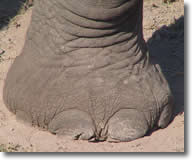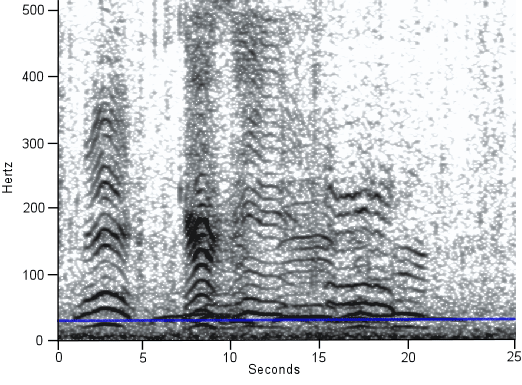Elephant Infrasound Communication
Biology 342 Fall '06

Mechanisms of Infrasound Communication
Production of infrasound signals
Vocalization, including infrasound vocalization, takes place in the larynx of the elephant. In the lanrynx, there are folds of tissue called vocal folds, which are the source of these vocalizations. When air from the lungs is forced over these vocal folds, they will vibrate [2], and producing soundwaves. In infrasound signals, the frequency of these soundwaves is very low (between 15 and 25 Hz) [1], [2]
The vocal folds in the larynx of elephants are especially flexible (compared to other mammals). This in part because of the hyoid apparatus (a series of bones at the base of the elephant's tongue), which consists of only five bones instead of the typical nine-bone arangement in most other mammals. Thus, the hyoid apparatus is only loosely connected to the cranium through muscles, ligaments, and tendons rather than by bones. This anatomical feature provides greater flexibility, to produce lower frequency calls. The vocal folds are very long in comparison to other terrestrial mammals [1].

Click on image to
learn more about it.
Travel of infrasound signals
Infrasound waves can travel very far between animals. Infrasound signals have been reported to have been received by elephants from at least 4 km away from the source of the signal, and there is speculation that calls across distances of over 10 km canbe achievedl [3]. The wavelength of infrasound waves through the ground can be between 87 and 175 m at 20 Hz (compare this to 17.5 m at 20 Hz through the air!) [1]. The length of these soundwaves (and thereby the range of the signal) can be maximized by optimal conditions of various environmental factors. These include temperature (lower temperatures lengthens wavelengths), density of substrate (the more porous the substrate, the better it functions as a conductor), atmospheric humidity (less humid air provides for clearer signalling), and air turbulance (less turbulance is ideal for signaling) [3].
Perception of infrasound signals
Elephants can hear at the low frequency range of 15-25 Hz 10 to 100 times better than humans [1]. They can do this because of their large interaural distance, large ear drums, bulky ossicles (bones inside the ear) - [in the Indian elephant, ossicles are a massive 650 mg [7]], wide basilar membranes, diminished outer lamina, and thin, spongy inner lamina (this increases the flexibility) [1].
Elephants will also raise one foot when listening for distant infrasound signals. This is thought to increase sensitivity in the other feet [1].